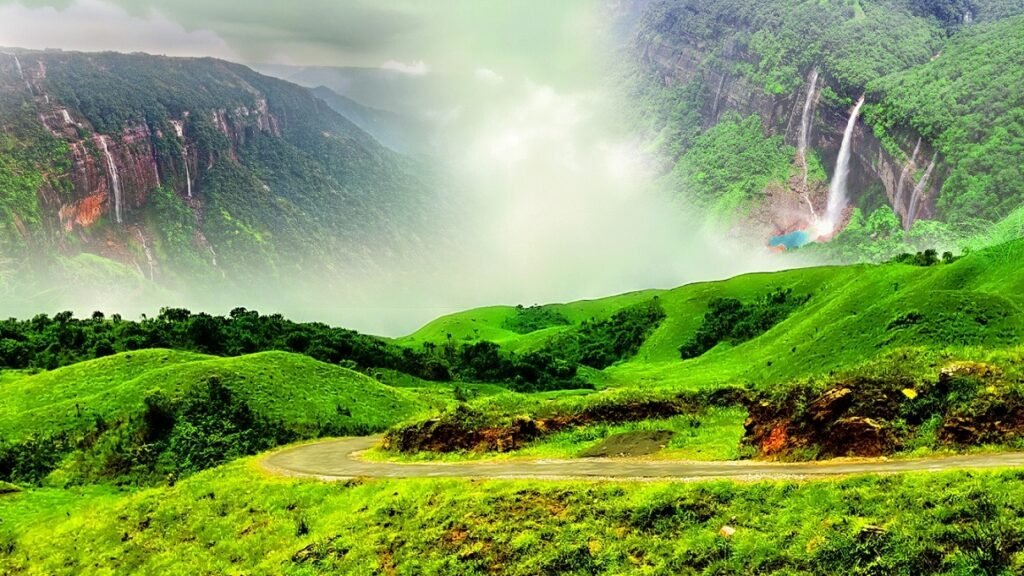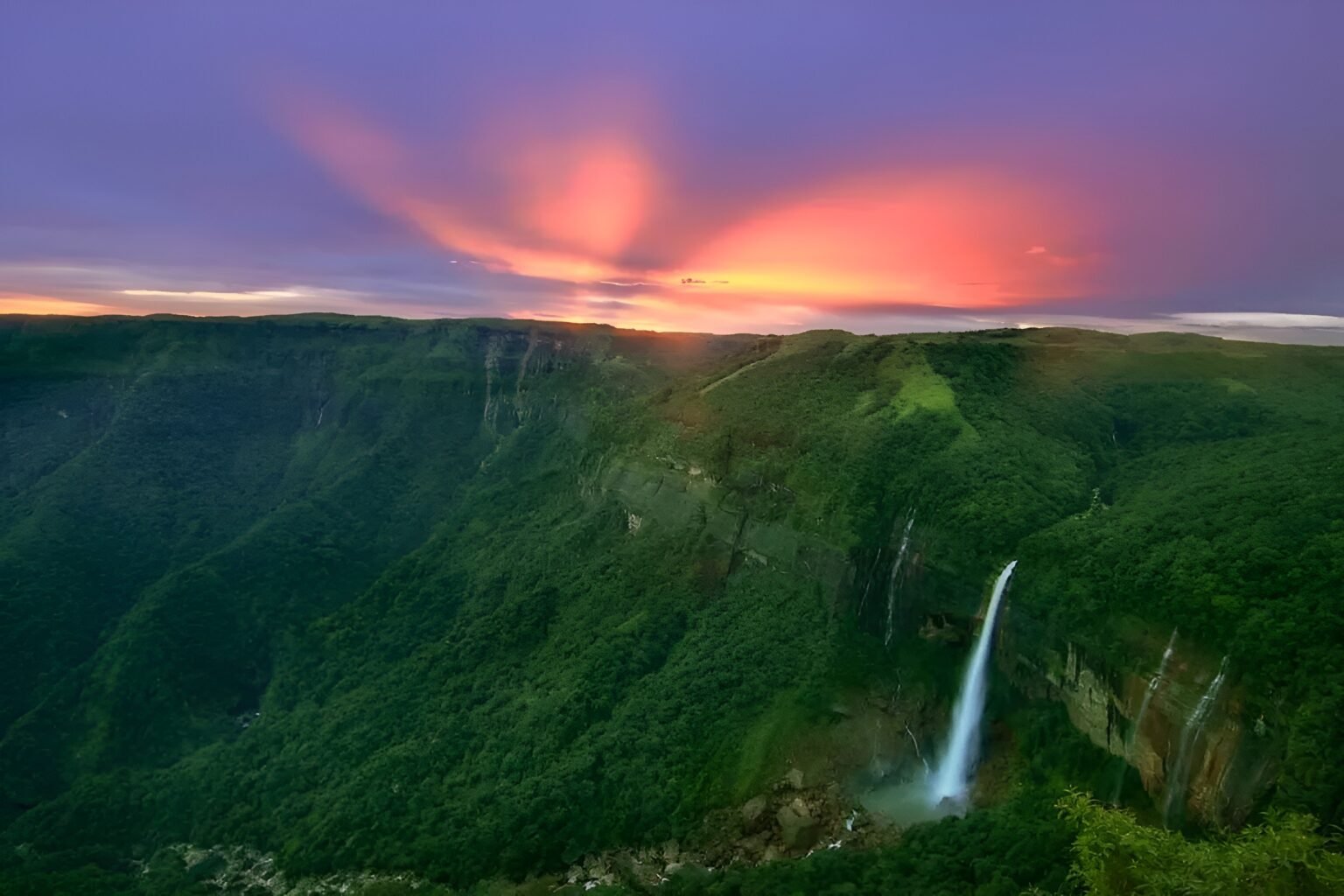Cherrapunji, also known as Sohra, stands as a vibrant gem in India’s northeast, offering enchanting landscapes, a mystical culture, and a record-breaking legacy as one of the wettest places on Earth. Nestled in the hills of Meghalaya, it boasts an ancient Khasi heritage, stunning natural wonders, unique living root bridges, and a growing eco-tourism sector that welcomes thousands of visitors every year.
Located roughly 54 km from Shillong, it (locally known as Sohra) is renowned globally for its staggering rainfall and breathtaking highland scenery. Perched on the southern edge of the Shillong Plateau, its misty valleys, tumbling waterfalls, and lush forests draw explorers, nature lovers, and cultural enthusiasts every season.
Location and Accessibility
Cherrapunji lies in Meghalaya’s East Khasi Hills district. The town sits at approximately 1,450 meters above sea level, overlooking the dramatic plains of Bangladesh to its south. The climate here is cool and misty, with persistent rain, especially during the monsoon season.
Travellers usually arrive via Guwahati, Assam, the nearest major airport and railway junction. From Guwahati, Cherrapunji is a scenic 150 km (5-6 hour) drive through rolling hills, lush forests, and picturesque valleys. Local transport includes taxis, buses, and hired cabs, with Shillong, which is 54 km away, being accessible by these means.
Route Guide: How to Reach Cherrapunji
- By Air: Fly into Lokpriya Gopinath Bordoloi International Airport (Guwahati), then drive 150 km or hire a taxi to Cherrapunji.
- By Rail: Reach Guwahati Railway Station, then catch a bus/taxi towards Shillong and onward to Cherrapunji.
- By Road: Regular bus services are available from Guwahati, with a distance of 146 km to Guwahati and 54 km to Shillong.
- By Taxi: Hired taxis from Shillong or Guwahati offer flexible stops and memorable scenery along the way.
Key Details:
History and Heritage
The history of Cherrapunji dates back centuries, serving as the traditional capital of the Khasi tribal kingdom, Ka Hima Sohra. Early encounters with Christian missionaries in the 18th century led to lasting cultural shifts, including the adoption of the Roman alphabet and the spread of Christianity. British colonial influence shaped its identity, with ‘Sohra’ anglicised to ‘Cherra’ and eventually ‘Cherrapunji’, meaning ‘land of oranges’. Its original name was reinstated in recent years, yet ‘Cherrapunji’ remains synonymous with the town’s magic.
Local Culture: Tribal Roots and Living Traditions
Cherrapunji’s population is predominantly Khasi, and the community thrives under a matrilineal system, where lineage is passed through mothers, ensuring that women play pivotal roles in society. Khasi culture is expressed through exuberant festivals, vibrant music, and expressive dances. Handwoven textiles, bamboo, and wood handicrafts reflect the deep ancestral skills of their makers, while oral storytelling preserves the legends and community values of the past.
Traditional cuisine features rice, pork, bamboo shoots, and locally harvested herbs. Iconic dishes include Jadoh (meat rice), Dohneiiong (pork with black sesame), and Shngalak (fish chutney). The rain-sculpted landscape also shapes the daily life and traditions of Cherrapunji’s people, most notably in the ingenious living root bridges that grow from the roots of Ficus trees, some of which have lasted over five centuries.
Major Tourist Spots
Cherrapunji is renowned for its breathtaking waterfalls and enigmatic caves. Nature meets engineering in the region’s legendary living root bridges:
Many visitors also stop by the monument to David Scott, a British administrator, in the town’s cemetery. Offbeat adventures include caving expeditions at Arwah and Krem Mawmluh, as well as butterfly-spotting in nearby forest parks.
List of Places to Visit
- Nohkalikai Falls
- Seven Sisters Falls
- Dainthlen Falls
- Double Decker Living Root Bridge
- Wei Sawdong Falls
- Mawkdok Dympep Valley
- Thangkharang Park
- Mawsmai Cave
- Garden of Caves
- Arwah Cave
- Krem Mawmluh
- Mawsynram Village
- David Scott Monument
Each destination offers a unique blend of natural beauty, adventure, and immersive local experiences.
Tourism Revenue and Economy
Tourism has significantly boosted Cherrapunji’s economy in recent years. Meghalaya’s tourist arrivals soared from 830,000 to 1.26 million between 2018 and 2023, with Cherrapunji and nearby locales leading the surge. Major festivals and eco-tourism initiatives, such as the Shillong Autumn Festival and Cherry Blossom Festival, drew tens of thousands of visitors. Local homestays, guides, transport, and handmade crafts contribute substantially to household and state revenues. Opportunities remain strong for sustainable tourism, striking a balance between development and conservation.
Cherrapunji’s Climate: Heaven of Rain
Cherrapunji once held the record for the planet’s highest annual rainfall: 26,461 millimetres (1,041.8 inches) in a single year. While the village of Mawsynram now claims the “wettest place” title, Cherrapunji’s showers and misty splendour remain unmatched. The heavy rain results from summer monsoon winds, which ascend the plateau’s southern slopes and rapidly cool, releasing vast amounts of condensed vapour.
Flora, Fauna, and Sustainability
The region’s biodiversity is phenomenal, with subtropical forests hosting rare orchids, ferns, butterflies, and exotic birds. Khasi customs promote harmony with nature, reflected in their reverence for sacred groves and forest preservation rituals. Sustainable tourism and community-led conservation projects aim to curb erosion and protect living root bridges and fragile cave systems from excessive visitor numbers.
Festivals and Events
Cherrapunji witnesses vibrant celebrations year-round. Tribal festivals showcase music, dance, and sporting contests, often accompanied by open-air feasts featuring Khasi delicacies. The region’s proximity to Shillong ensures access to major cultural events, such as the autumn and spring festivals, which further boost tourism and local revenue.
Ecotourism and Adventure Activities
Eco-tourism thrives here, offering activities that range from trekking and caving to bird-watching and local homestay experiences. Living root bridge treks are particularly popular, allowing travellers to marvel at the ingenuity and patience of Khasi craftsmanship. Waterfall hopping, hiking through rain-kissed valleys, and exploring ancient caves give visitors a thrill of adventure in pristine natural settings.

People and Demographics
The last census placed Cherrapunji’s population at about 10,086, with a slight female majority. Christianity is the principal faith, though indigenous Niam Khasi, Hinduism, and Islam are also observed in pockets. Khasi is widely spoken, alongside English, introduced by early missionaries.
Conservation Challenges
Heavy rainfall, erosion, and growing tourist traffic threaten fragile ecosystems and centuries-old root bridges. The community, together with government and NGOs, is actively involved in preservation projects that safeguard natural and cultural treasures, encouraging responsible travel.
Recent News
A surge in travellers visiting Cherrapunji this year has reaffirmed its status as northeast India’s premier eco-tourism hotspot. Visitors continue to flock to see its misty valleys, living root bridges, and thundering waterfalls. With record arrivals, local Khasi communities, government bodies, and NGOs collaborate to protect both the cultural legacy and environmental fragility of Cherrapunji. Attractions like Nohkalikai Falls and Seven Sisters Falls now benefit from enhanced infrastructure, guided tours, and robust eco-friendly measures, ensuring sustainability for generations to come.
FAQs About Cherrapunji
Why is Cherrapunji famous worldwide?
Cherrapunji is renowned globally for its record-breaking annual rainfall and as the historic gateway to Meghalaya’s natural wonders, including towering waterfalls and living root bridges.
What are the essential sights in Cherrapunji?
Must-see attractions include Nohkalikai Falls, Seven Sisters Falls, Mawsmai Cave, Double Decker Living Root Bridge, and Dainthlen Falls, each offering unique natural and cultural experiences.
How can tourists reach Cherrapunji?
Travellers usually reach Cherrapunji via Guwahati by air or train, followed by a road trip or taxi through Shillong and into the hills of Meghalaya.
What is unique about the Khasi culture in Cherrapunji?
The Khasi society is matrilineal and renowned for its vibrant festivals, living root bridges, handwoven textiles, and rich oral storytelling traditions.
What is the best season to visit Cherrapunji?
The post-monsoon months, September to November, offer clear views and mild weather. Waterfalls and forests are lush, while the cloud cover is less intense.
Is Cherrapunji suitable for adventure and eco-tourism?
Absolutely, trekking, caving, bird-watching, and experiencing root bridges make Cherrapunji a haven for eco-tourists and thrill-seekers.
How do local communities protect Cherrapunji’s heritage and environment?
Local organisations and tribal leaders collaborate with tourism operators to conserve natural wonders, promote sustainable practices, and educate tourists on respectful travel.
What cuisine should visitors try in Cherrapunji?
Visitors should sample Khasi dishes like Jadoh (rice and meat), Dohneiiong (pork with sesame), and local chutneys, which reflect the town’s rich culinary heritage.

